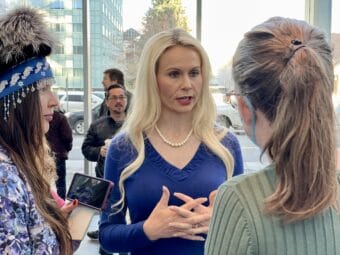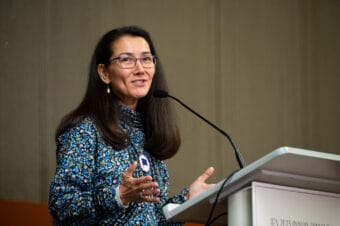
Former Alaska governor and vice presidential candidate Sarah Palin entered the race late Friday afternoon to fill the remaining months of Congressman Don Young’s term.
“As I’ve watched the far left destroy the country, I knew I had to step up and join the fight,” Palin said in an emailed news release.
Palin joins more than 50 other people who have filed to represent Alaska in the U.S House of Representatives.
Friday — April Fool’s Day — at 5 p.m. was the candidate filing deadline, and the Division of Elections is still finalizing the list.
Tara Sweeney also announced late this afternoon that she’s running. She was assistant secretary of Indian Affairs at the Interior Department during the Trump administration and is a former executive at Arctic Slope Regional Corporation.
Others who threw their hat in the ring include Alaska Rep. Adam Wool, D-Fairbanks, state Sen. Josh Revak, R-Anchorage, and Anchorage Assembly member Chris Constant, a Democrat.
Surgeon Al Gross, who raised millions in his unsuccessful 2020 campaign to unseat U.S. Sen. Dan Sullivan, is running for the House seat.
At least three former legislators are in the race: Mary Sattler Peltola of Bethel, John Coghill of Fairbanks and Andrew Halcro of Anchorage.
Other entrants are Anchorage garden columnist Jeff Lowenfels and Santa Claus. That’s the North Pole city council member whose legal chosen name is Santa Claus.
The candidate with the biggest head start is Nick Begich III.
“I’ve been in the race for five months, and we’ve raised more money than any other candidate in the race by a factor of perhaps five,” he said in a recent interview. “We’ve traveled all over the state. We’ve met with thousands of Alaskans already.”
He’s the grandson of Congressman Nick Begich, who held the Alaska seat before Young. Unlike most of the Begich clan, this Begich is a Republican, and he entered the race initially to take the seat away from Young.
Begich raised $300,000 by the end of last year — about half from others and half from his own pocket. So far this year, he says he’s raised more than $1 million, though his campaign didn’t say how much of that came from contributions and how much from the candidate.
Many of Don Young’s inner circle are mad at Begich for attacking Young. Some are backing Sen. Revak, who was co-chair of Young’s reelection effort.
Young’s long-time strategic and media consultant, Art Hackney, said he and others were already building Revak up to be a future candidate to replace Young.
“We thought that future would be a couple of years down the road, with Congressman Young finishing out a term,” Hackney said. “But the structure of a congressional race for him is being put into place, over a period of time. So he’s got a lot of he’s got a lot of pieces in place.”
This special election will be the first to employ Alaska’s new voting system. It begins with an open primary, with all candidates on one ballot. Voters will rank candidates in the general, but in the primary they can only select one candidate.
With more than 50 candidates in the race, it may be hard for voters to choose. Should they opt for a candidate they like, or the candidate they think has a chance to be among the top four who will advance to the general?
“There’s no need to be strategic,” said Jason Grenn, executive director of Alaskans for Better Elections. The group promotes the merits of Alaska’s ranked choice voting and the open primary. In the primary, Grenn said, voters can just pick the candidate they like best.
“And if that person has a shot at making the top four, that’s great,” he said. “And if they don’t, (with) the top four, there’s enough diversity in the field of candidates that I think many voters are going to find someone who is intriguing or shares their philosophies in the top four.”
It’s better than the old system, he said, which essentially reserved one spot on the ballot for both major parties.
The special primary will be by mail. You can check with the Division of Elections to see if your current address is on file. The ballots need to be mailed back by June 11.



